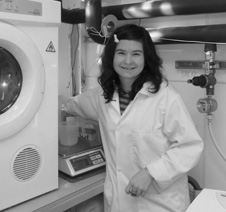
Frankie Daroux has always been quite keen on clothes and fashion, and she has always been VERY keen on science. Growing up in Auckland, she was also quite keen on getting away to somewhere new… so a degree in Clothing and Textile Sciences at University of Otago appealed on a number of levels….
“I wanted to study something a bit different, and I really enjoyed the very direct application of the science of clothing and textiles. We studied a lot of industry-related real world applications. You could really see how what you studied applied to real life, with the relationship between people and clothing and the environment. It was great!”
Frankie is back in Auckland now, working as a Graduate Product evaluator for Fisher and Paykel's washing machine range. Her work involves checking that all machines comply with industry standards, testing to make sure changes in engineering don't affect the functionality of the washers and developing investigations into the trade-offs involved in changes to washing cycles.
“There are always trade-offs: if you wash clothes hotter, they get cleaner but the fabric may suffer damage; if you wash cooler but longer, will there be more wear? Those are the kinds of compromises we explore!”
Frankie made the most of her time in Dunedin, enjoying lots of skiing and cricket as well as being part of the Red Cross Emergency response team. She really enjoyed her studies too, exploiting the range of topics available in Clothing and Textile Sciences.
“There are lots of papers, and they cover the science as well as social aspects of clothing, the economics of international trade, fashion production… but it was the science that I really enjoyed! Doing the research is very cool, and the department is very research-intensive.”
Frankie completed a BSc in Clothing and Textile Sciences and then an MSc in 2009. The research for her Masters explored how washing a garment might mask forensic evidence of blunt force trauma. Again, the direct application of this research is obvious.
